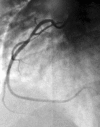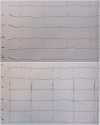STEMI Secondary to Coronary Vasospasm: Possible Adverse Event of Methylphenidate in a 21-Year-Old Man with ADHD
- PMID: 27747690
- PMCID: PMC5033796
- DOI: 10.1007/s40800-016-0035-7
STEMI Secondary to Coronary Vasospasm: Possible Adverse Event of Methylphenidate in a 21-Year-Old Man with ADHD
Abstract
Methylphenidate (Ritalin®) is an increasingly used medication in the treatment of attention-deficit hyperactivity disorder (ADHD). Cardiovascular adverse effects like vasospasm or myocardial infarction are described as very rare adverse effects. We present the case of a 21-year-old man diagnosed with ADHD who recently started therapy with Ritalin® Adult 20 mg for at least 3 days. Afterwards he presented with chest pain, elevated troponin and creatine kinase, and posterolateral ST elevations. A myocarditis was initially supposed. In the coronary angiography, signs of coronary artery spasm could be found. The echocardiography showed mild left ventricular dysfunction; no acute myocarditis could be found in the cardiac MRI and myocardial biopsy. The medication with methylphenidate was stopped, and after 12 days the asymptomatic patient was discharged from hospital.
Conflict of interest statement
Timo-Benjamin Baumeister, Ingo Wickenbrock and Christian Perings declare that they have no conflicts of interest. Consent Written informed consent was obtained from the patient for publication of this case report. A copy of the written consent is available for review by the corresponding author of this article. Study funding statement No financial support was received for the preparation of this manuscript.
Figures
References
-
- Ruwald MH, Ruwald AC, Tonder N. Methylphenidate induced ST elevation acute myocardial infarction. Ugeskr Laeger. 2012;174:647–648. - PubMed
-
- Lamberti M, Italiano D, Guerriero L, D’Amico G, Siracusano R, Ingrassia M, Germanò E, Calabrò MP, Spina E, Gagliano A. Evaluation of acute cardiovascular effects of immediate-release methylphenidate in children and adolescents with attention-deficit hyperactivity disorder. Neuropsychiatr Dis Treat. 2015;11:1169–1174. doi: 10.2147/NDT.S79866. - DOI - PMC - PubMed
LinkOut - more resources
Full Text Sources
Other Literature Sources




